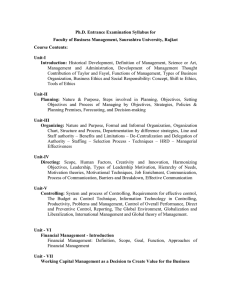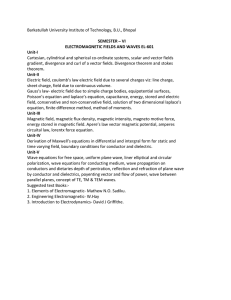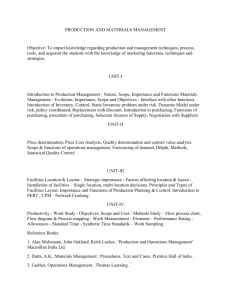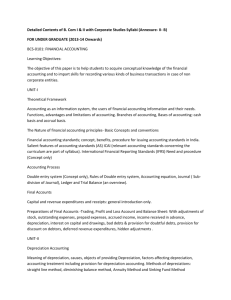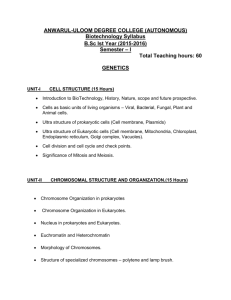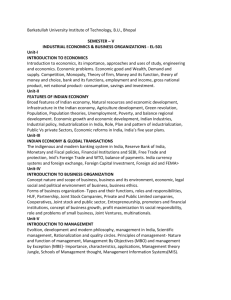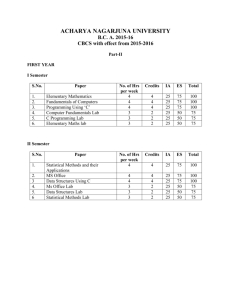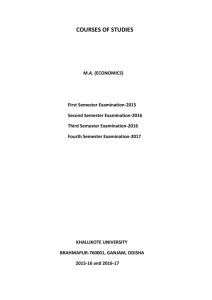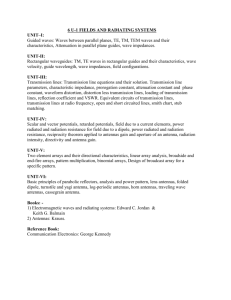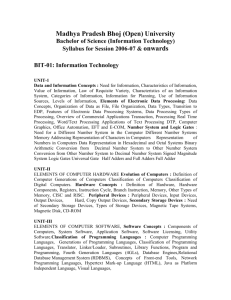ece ii semester
advertisement
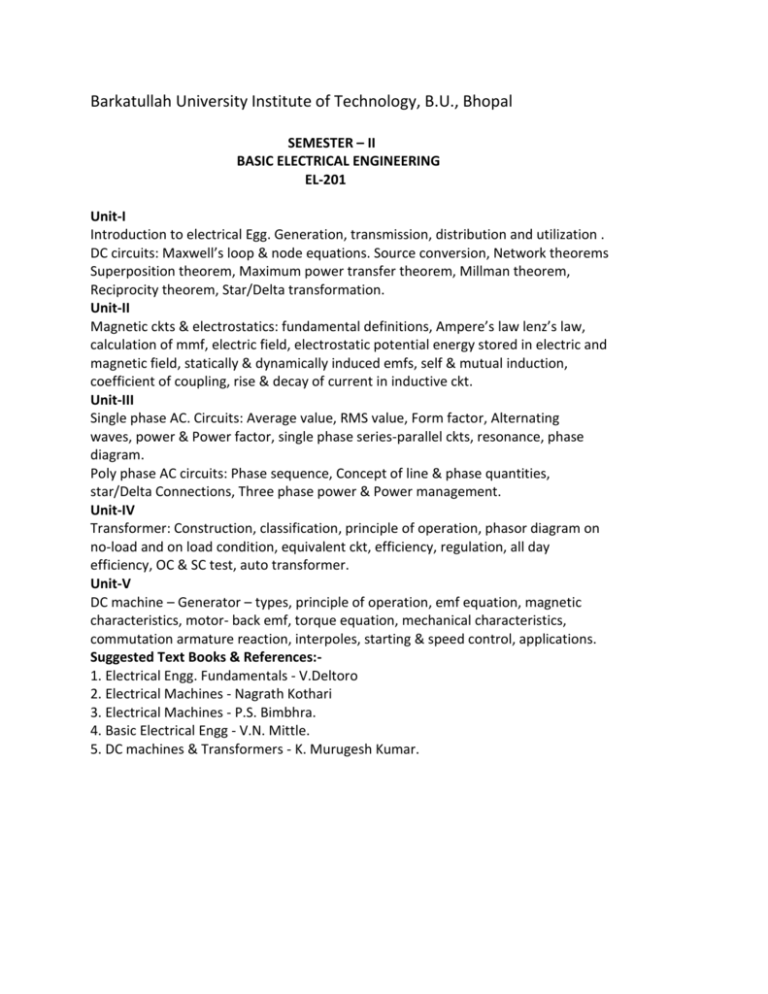
Barkatullah University Institute of Technology, B.U., Bhopal SEMESTER – II BASIC ELECTRICAL ENGINEERING EL-201 Unit-I Introduction to electrical Egg. Generation, transmission, distribution and utilization . DC circuits: Maxwell’s loop & node equations. Source conversion, Network theorems Superposition theorem, Maximum power transfer theorem, Millman theorem, Reciprocity theorem, Star/Delta transformation. Unit-II Magnetic ckts & electrostatics: fundamental definitions, Ampere’s law lenz’s law, calculation of mmf, electric field, electrostatic potential energy stored in electric and magnetic field, statically & dynamically induced emfs, self & mutual induction, coefficient of coupling, rise & decay of current in inductive ckt. Unit-III Single phase AC. Circuits: Average value, RMS value, Form factor, Alternating waves, power & Power factor, single phase series-parallel ckts, resonance, phase diagram. Poly phase AC circuits: Phase sequence, Concept of line & phase quantities, star/Delta Connections, Three phase power & Power management. Unit-IV Transformer: Construction, classification, principle of operation, phasor diagram on no-load and on load condition, equivalent ckt, efficiency, regulation, all day efficiency, OC & SC test, auto transformer. Unit-V DC machine – Generator – types, principle of operation, emf equation, magnetic characteristics, motor- back emf, torque equation, mechanical characteristics, commutation armature reaction, interpoles, starting & speed control, applications. Suggested Text Books & References:1. Electrical Engg. Fundamentals - V.Deltoro 2. Electrical Machines - Nagrath Kothari 3. Electrical Machines - P.S. Bimbhra. 4. Basic Electrical Engg - V.N. Mittle. 5. DC machines & Transformers - K. Murugesh Kumar. Barkatullah University Institute of Technology, B.U., Bhopal ENGINEERING CHEMISTRY EL-202 Unit-I Source & impurities, Alkalinity & PH hardness of water. Degree of hardness. BOD,COD and their determination. Standard of Water for drinking purposes. Purification of water for domestic uses. Methods of sterilization, methods of water softening, lime soda process. Zeolite and ion exchange resin processes. Scale formation Causes. Effects and prevention. Caustic embrittlement, priming foaming, boiler corrosion and de-aeration simple numerical problems on water softening and analysis. Unit-II Fuels. Classification of fuels and their comparison, calorific values, fuel resources in India, analysis of coal clinker formation. Pulverized coal as fuel, methods of manufacture of coke and uses, petroleum distillation. Cracking cracked gasoline. Varieties of fuel oils, their properties and uses, knocking, anti knocking compounds. Problems based on combustion. Unit-III Materials Composition engineering properties and uses of alloys of Al. Fe. Ni Cu and Zn. Refractories: definition. Classification, properties and uses: Types of Cements .manufacture. properties and uses of Portland Cement, Chemistry of setting hardening of Cement. Polymers: Polymerization, different types of polymers. Plastics. Their preparation engineering properties and uses. Silicones . natural and synthetic rubbers, their properties and uses, adhesives. Unit-IV Lubricants Types and classification of lubricants, mechanism of lubrication, physical and Chemical properties testing of lubricants types of greases, application of lubricants. Corrosion and corrosion reaction, types and theories of corrosion, factors affecting the rate of corrosion, protection of metal from corrosion by various measures, important inorganic metallic and non metallic coatings and organic coating. Unit-V Basic environmental chemistry and Instrumental techniques in chemical analysis. A. Pollution, cause of pollution, air pollution and its types, green house effect, importance of ozone layer, control of air pollution, water pollution, sources, methods of prevention, sewage and its treatment, soil and land pollution and its control, radio active pollution and its control. B. Introduction, infrared, UV,NMR, spectrophotometry, chromatograph, gaschromatography, colorimetry, Lamberts and beer’s law. Suggested Text Books:1.Engineering Chemistry by Jain & Jain – Dhanpat Rai & Sons, New Delhi 2.A Test book of Engineering Chenistry by S.S. Dara S. Chand & Co. Lted. New Delhi Barkatullah University Institute of Technology, B.U., Bhopal 3. Krishna’s engineering Chemistry by B.K. Sharma – Krishna Prakashan, Meerut. 4. A book of Practical Engineering Chemistry by Mittal by Kapoor & Mittal- Kedar Nath Ram Nath, Meerut. BASIC MECHANICAL ENGG. EL-203 Unit-I Boilers- Names and function of principal parts, Cochran, Locomotive, Babcock and Wilcox boilers, boiler mountings and accessories. Steam Sensible heat, Latent hear, super heat, internal energy, dryness fraction and its determination processes constant pressure, constant volume, hyperbolic and throttling. Unit-II IC Engines: Classification of I.C. Engines, description and working of four stroke cycle petrol and diesel engines, two stroke cycle petrol engine and their working cycles, indicated power, brake power and efficiencies. Thermodynamics – system properties and processes, Zero, first second and third law of thermodynamics. Unit-III Modes and application of heat transfer unidirectional steady state heat conduction, heat transfer through composite slab, Air conditioning- need and application, description of summer and winter air conditioning. Workshop Technology. Unit-IV Introduction to materials machine tool and metrology: Engineering materials: Classification, composition, mechanical properties and uses of cast iron, mild steel, high carbon steel and high speed steel. Machine tool: introduction, specification construction and uses of lathe, drilling, shapes milling and grinding machines. Measurement: construction and uses of measuring tools and gauges, surface plate, dial gauge, sine bar, caliper, micrometer, comparators. Unit-V Foundry and Fabrication: Foundry: Basic steps involved in foundry. Introduction to patterns, types material allowances, mould making, composition of molding sand i.e. green sand, dry and loam sand, Fabrication: Welding and types of weld ability of material. Introduction to gas and are welding- TIG,MIG and submerged, resistance welding, soldering and brazing & related process. Suggested Text Books:1. Manufacturing technology vol. I& II Raghuwanshi. 2. Workshop Technology Vol.I & II Hazara Choudhary. 3. Workshop Technology Vol.I & II P.N. Rao. ENGG.MECHANICS EL-204 Unit- I Co-plainer Forces, free body diagrams, Varignon’s Theorem, Condition of Equilibrium, force polygon and funicular polygon of forces and equivalent force system, Analysis of forces in the members of a truss, method of joins, Method of section. Unit-II Centroid and mount of Inertia of plane areas, perpendicular Axis and theorems, product of Inertia, Radius of gyration, Principal Axes and principal Mount of Inertia, Mass Mount of Inertia. Unit-III Friction on inclined plane, screw & nut friction, ladder wedge friction, Transmission of power through belt, and rope, gear Trains, simple, compound and Epicyclic. Unit-IV Kinematics and kinetics of particle, motion under constant force, Super elevation of rails, Momentum and Impulse, D’ Alembert’s Principal, Work energy principle, Collision of elastics bodies, rigid body dynamics, Kinematics and Kinetics of rigid body, Flywheel, Unit-V Shear force & bending moment diagram in cantilever & simply supported beam with concentrated, distributed load, and couple, overhanging beams , pint of contra-flexure, relationship between load, bending moment & shear force. Suggested Text Books:1. Applied Mechanics by S.B. Jummarkar. 2. Engg. Mechanics by R.K. Rajput. 3. Applied mechanics by I.B. Prasad. Barkatullah University Institute of Technology, B.U., Bhopal DATA STRUCTURE AND ALGORITHMS EL-205 Unit-I Introduction to Algorithms, concept of time and space complexity of algorithms to recursion, running time calculation of algorithms. Introduction to data structure, arrays, representation and manipulation of multidimensional arrays. Unit-II Introduction to linked lists, doubly linked lists, stacks queues implementation and manipulation of these data structures. Unit-III Trees- Basic terminology and representation, Binary trees, Binary tree traversal, Binary search tree, applications of trees. Unit-IV Graphs- Basic terminology and representation, graph traversal connected compound and spanning trees, shortest pathDijkstra’s algorithm. Unit-V Study and analysis of various internal sorting techniques- Insertion sort, quick sort, merge sort, heap sort. Introduction to external sorting- need and techniques. Suggested Text Books:1. Fundamental of Data Structures by Horowitz & Sahani. 2. Data structure in C and C++ by A.S. Tanenbaum.
